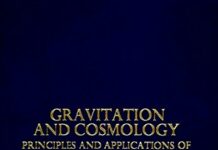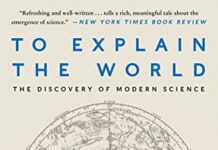
Ebook Info
- Published: 2022
- Number of pages: 243 pages
- Format: PDF
- File Size: 2.07 MB
- Authors: Steven Weinberg
Description
A Nobel Prize-winning physicist explains what happened at the very beginning of the universe, and how we know, in this popular science classic. Our universe has been growing for nearly 14 billion years. But almost everything about it, from the elements that forged stars, planets, and lifeforms, to the fundamental forces of physics, can be traced back to what happened in just the first three minutes of its existence.In this book, Nobel Laureate Steven Weinberg describes in wonderful detail what happened in these first three minutes. It is an exhilarating journey that begins with the Planck Epoch – the earliest period of time in the history of the universe – and goes through Einstein’s Theory of Relativity, the Hubble Red Shift, and the detection of the Cosmic Microwave Background. These incredible discoveries all form the foundation for what we now understand as the “standard model” of the origin of the universe. The First Three Minutes examines not only what this model looks like, but also tells the exciting story of the bold thinkers who put it together. Clearly and accessibly written, The First Three Minutes is a modern-day classic, an unsurpassed explanation of where it is that everything really comes from.
User’s Reviews
Reviews from Amazon users which were colected at the time this book was published on the website:
⭐I review the first hardcover printing (1977, which includes ten-page mathematical supplement). My first reading of this book occurred 1977. My second reading of the book occurred 2017. I wanted to re-read this book ! Between those two years (1977 and 2017) much has transpired: my background education and cosmological research. Regarding my education, I have had the pleasure of studying from Steven Weinberg’s great textbooks (beginning with Gravitation and Cosmology and concluding with his Lectures On Quantum Mechanics). Regarding Cosmology, I am young enough (and old enough) to have witnessed the birth of string theory and inflation theory, plus the discoveries of Higgs boson and gravitational waves. There is still ‘dark energy’ to contend with ! Be that as it may, Steven Weinberg’s ” First Three Minutes” is the first serious introduction to Cosmology I ever read. It still excites me (that is, the book and Cosmology) !Let me quote from Steven Weinberg:(1) “…an explosion which occurred simultaneously everywhere, filling all space from the beginning, with every particle rushing apart from every other particle.”(page 5). Think about how often this concept, this ‘Big Bang’ gets muddled in the classroom discussions. Many have failed to read this line !(2) “However, even if it is eventually supplanted, the standard model will have played a role of great value in the history of Cosmology.” (page 9). Think about how often many fail to underscore the provisional nature of theories ! Steven Weinberg is well aware of limitations of physical theory.(3) Read: “As often happens in science, this argument can be used both forward and backward,” and “if the universe is isotropic around every point, it is necessarily also homogeneous.” (page 23). You have a masterful educator presenting subtleties. Kinematics occupied initial thirty pages, dynamics (Newton and Einstein) begins page 31, and we now know that this will need emendation…(4) Read: “The galaxies are not rushing apart because of some mysterious force that is pushing them apart, rather, the galaxies are moving apart because they were thrown apart by some sort of explosion in the past.” (page 35).(5) “No signal can travel faster than the speed of light, so at any time we can only be affected by events occurring close enough so that a ray of light would have had time to reach us since the beginning of the Universe.” (page 41). The concepts causality and horizon, thus introduced.(6) Chapter three, Cosmic Microwave Radiation Background, is a favorite. Weinberg’s terminology “background radio static” is apt. Weinberg writes-out ‘degrees Kelvin,’ which, I believe is redundant (one need not write ‘degrees’ ). Read: “…although in a sense the Universe was expanding very rapidly at first, to an individual photon or electron or nucleus, the expansion was taking plenty of time—time enough for each particle to be scattered or absorbed or re-emitted many times as the Universe expanded. (page 55). It is here where the concept of thermal equilibrium is introduced and it is here where the topic of statistical mechanics first charmed me ! We learn that, strictly speaking “temperature” is only defined for thermal equilibrium and “it is crucial to the argument of this book that the Universe has once passed through a state of thermal equilibrium.” (page 56). Much Physics in that one line !(7) Photons, Black-Body Radiation, Stefan-Boltzmann Law, Planck’s Energy Quanta: Chapter Three presents a veritable qualitative course in modern physics. We meet our friend Rainier Weiss (2017 Physics Nobel Prize Laureate).(8) Read: “Eventually, as we look farther and farther back into the history of the Universe, we come to a time when the temperature was so high that collisions of photons with each other could produce material particles out of pure energy.” That is a first hint of quantum field theory, read: “to every type of particle in nature, there is a corresponding antiparticle.” (page 82 ). Next: “it is the balance between the gravitational field and the outward momentum of the contents of the Universe that governs the rate of expansion.” Finally, the conserved quantities electric charge, baryon number and lepton number are described (page 92, chapter four). An introduction to particle physics !(9) The first hundred pages have been preparation for chapter five: The First Three Minutes. It is here where it is all put together, assembled. Weinberg discusses neutrino background, among other things. Read his concluding words: “the appropriate response to such uncertainties is not to scrap the standard model, but rather to take it very seriously and to work out its consequences thoroughly, if only in the hope of turning up a contradiction with observation. (page 120). Words spoken by an honest scientist !(10) “The present Universe is so cold that the symmetries among the different particles have been obscured by a kind of freezing; they are not manifest in ordinary phenomena, but have to be expressed mathematically, in our gauge field theories.” (page 149). Yet another clue ! The book is completed. There is an eight page Glossary (always helpful) and a ten page mathematical supplement. That supplement includes: doppler effect, critical density, expansion time scales, black-body radiation, Jeans mass, neutrino temperature and density (using algebra and introductory physics). The supplement itself could be utilized for teaching, but being only ten pages the discussion needs to be amplified by the reader. References for further reading concludes the book. Among those references are textbooks which every physicist should study: Gravitation (Misner, Thorne, Wheeler), Large Scale Structure of Space-Time (Hawking and Ellis), Gravitation and Cosmology (Weinberg’s own monograph). Returning to “The First Three Minutes”–there is plenty enough in this book to keep you thinking !
⭐This book is well done and the author is enthusiastic about the topic. The language is non-technical for the most part and easy to follow. The book has an appendix which goes over the mathematics for those who want a more detailed explanation.The copyright is 1977 with a revision in 1988. The author was aware of dark matter at the time of the revision but not dark energy. This makes some of the book inaccurate. Also the Higgs field was not known and this makes the book almost not relevant.Overall, I would look for a book that has a copyright of at least 2010 to be up to date on the topic of how the universe was formed in the first several minutes.
⭐Examines in detail the onset of the Big Bang.
⭐Published in 1977 “The First Three Minutes” was an immediate hit with the general lay-public, from teens to adults, and instantly reset the bar for quality science writing for all science books that followed. Written by American theoretical physicist and future Nobel Laureate Steven Weinberg, it introduces the wonders of Cosmology and Physics to “anyone willing to puzzle through some detailed arguments”, in this he was eminently successful. In the 1993 edition he wrote a new preface and an “Afterword: Cosmology Since 1977” in which he updates some features of the book, but, for the most part, the main text was left pretty much as is. Though written for interested layperson the book also attracted a lot of attention among his professional colleagues as well and has continued to do so up to the present day. It’s not surprising to find Weinberg and/or “The First Three Minutes” referenced in moderne day books by Brian Greene, Michio Kaku, Stephen Hawking and Carl Sagan along with a host of others. Be that as it may, there have been a lot of changes in this branch of Physics, new research and observations have altered the way we look at The Big Bang and the first few minutes of our universe. In spite of these modern alterations the original theory’s basic tenet is still valid. Any “stale dated” issues that may or may not be present should not alter the benefits of this book for the general reader. Just keep in mind when the book was written and use that as a jumping off place for more recent works. Dr Weinberg’s writing is smooth and entertaining while keeping the scientific jargon and mathematical underpinnings to a minimum. To help the reader understand what science thinks the first minutes were really like Dr Weinberg provides an overview of some other Cosmological properties like; the expansion of the universe, the cosmic microwave background radiation, thermal equilibrium and absolute time units. In the latter half of the book Weinberg takes a brief look at the human side of physics history, specifically the mystery of why it took so long to discover the CMB, he also engages in a little bit of self-criticism as to his part in that long delay. With this background info the reader is ready to tackle the Big Bang’s first three minutes and on down to the first one-hundredth second. Modern day theories didn’t just come out of nowhere, fully formed and ready to go, they got their start in the minds of forward thinking scientist who often contemplate possible explanations for their observations and research. In reading the 1977 text I noticed a few hints of Things To Come. As the universe expanded there was some indication of a unknown force pushing space outward while some kind of invisible matter seemed to be slowing it down (dark energy and matter?). Weinberg mentions isolated patches of space that were like “Domains” with different rates of expansion and he poses a question: Do we live in one of those Domains? (Sounds like the Multiverse to me). While Weinberg doesn’t mention things like Dark Matter/Energy or alternate Universes in the original text he does cover those issues in the 1993 update as well as other modern concepts like String Theory and a kind of super-space filled with a bubbly froth of different universes/dimensions. From this interested layman’s point of view “The First Three Minutes” is an important look back at where modern science has come from and where it’s going in the future as new research and observations lead us down some previously untraveled roads to a new world-view and a different way of looking at the universe around us. I had no technical or formatting problems with this Kindle edition.Last Ranger
⭐Weinberg is at home both in cosmology and in elementary particles, so i just trust him that he made a very good selection of what topics to present. His writing style is similar to what he radiates on photos: composed, not exuberant. His sentences are all clear and simple.In the preface Weinberg writes that he intends his book for people who do not speak his language, meaning he bans formulas (but not numbers of temperatures, particle proportions etc.) into mathematical supplements, and shows some pictures and graphics but only few x-y-plots with explicite numbers. As a consequence the book gets longer, and the information gets more diluted.I really liked the tables, mathematical supplements, and also the afterword (written in 1993) at the end of the book, but was a bit bored in the main part of the book (150 pages), because the pace was too slow for me.To note: Physical quantities are given in cgs units, and large numbers are first given in long words, and then sometimes in the much shorter power of ten notation; e. g. on page 101: fifteen hundred thousand million degrees Kelvin (1.5×10^12 ° K).
⭐This is already third or fourth case when, on Amazon, I buy a book advertised as NEW, but it turns out used, and in poor condition. Amazon should do their job and make sure there is a correspondence between the description of the merchandize and the actual condition. Otherwise it borders on customer fraud.
⭐It had to be a winner after watching Steven on world science festival on YouTube. It didn’t disappoint. Such an important time of the world’s existence and he explains it in simple detail , both factual and conceptual. A must read if this is the time you are looking to explore.
⭐Nicely structured with just enough detail/repetition to allow non-scientists with maths and physics at A-Level etc to follow. This is not for those without any background knowledge though. Or close-minded creationists who choose to ignore what science can observe!
⭐when you here it all from the horses mouth as it were then it all becomes real – even if the material is all fantastically unreal! I mean – the first 3 minutes of the universe ! extraordinary concepts dealt with in straightforward understandable language…true scholarship..
Keywords
Free Download The First Three Minutes: A Modern View Of The Origin Of The Universe in PDF format
The First Three Minutes: A Modern View Of The Origin Of The Universe PDF Free Download
Download The First Three Minutes: A Modern View Of The Origin Of The Universe 2022 PDF Free
The First Three Minutes: A Modern View Of The Origin Of The Universe 2022 PDF Free Download
Download The First Three Minutes: A Modern View Of The Origin Of The Universe PDF
Free Download Ebook The First Three Minutes: A Modern View Of The Origin Of The Universe



